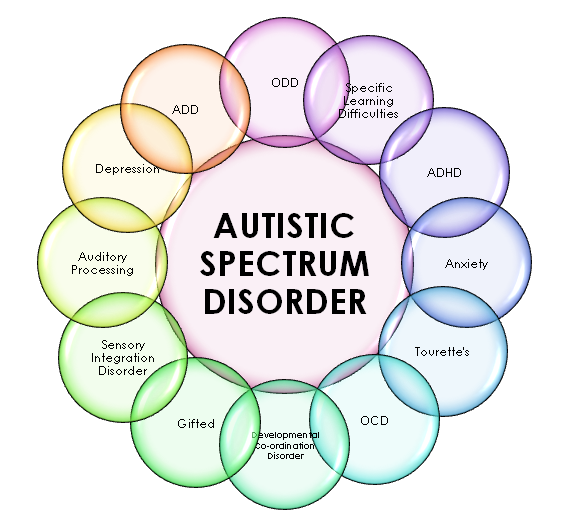The Duty of Education And Learning in Supporting Students with Autism: Ideal Practices
The Duty of Education And Learning in Supporting Students with Autism: Ideal Practices
Blog Article
Understanding Autism: A Comprehensive Guide to Symptoms And Signs
Autism Range Problem (ASD) includes a large array of features that can dramatically affect a person's social communications and day-to-day performance. Understanding these subtleties not just help caregivers and instructors in supplying ideal assistance but likewise fosters an extra inclusive environment for people with ASD.
Overview of Autism Range Disorder
Defining Autism Spectrum Disorder (ASD) entails identifying it as a complex neurodevelopmental problem identified by a series of obstacles in social interaction, communication, and behavior patterns. The term "spectrum" mirrors the wide variability in signs and symptoms and their intensity, which can differ significantly from one person to an additional. ASD usually manifests in early childhood, although some individuals might not receive a diagnosis up until later on in life.
Factors influencing the growth of ASD consist of environmental variables and genetic tendencies, although the specific causes continue to be under investigation. Medical diagnosis frequently relies upon behavioral assessments, as there are no conclusive clinical tests for ASD. Early intervention is critical and can significantly improve results, concentrating on boosting interaction skills, social interactions, and flexible habits.
Individuals with ASD might additionally show one-of-a-kind strengths, such as remarkable focus to information or details areas of knowledge. Comprehending the diverse nature of ASD is essential for promoting an inclusive environment that fits neurodiversity. Continued research is crucial for creating efficient treatments and support systems, allowing people with ASD to flourish and meet their potential within culture.
Common Signs of Autism
Acknowledging the common signs of Autism Spectrum Condition (ASD) is important for early recognition and intervention. These indications can differ extensively in intensity and presentation, however specific characteristics are regularly observed in individuals with ASD.
Among the most common indicators is a marked difficulty in preserving and developing eye contact. People may additionally display limited interest in social communications and show a preference for solitary play. Repeated habits, such as hand-flapping, rocking, or rotating things, often arise early in childhood. In addition, some youngsters might establish rigorous routines and come to be troubled if these routines are interrupted.
Sensory sensitivities are likewise typical; people might underreact or overreact to sensory stimuli, such as sounds, lights, or structures. autism. Language growth can be irregular, with some youngsters displaying delayed speech or using language in uncommon ways, including echolalia-- duplicating sentences or phrases heard elsewhere
It is vital to keep in mind that not every individual with ASD will certainly show all these indicators, and the level of these actions can vary dramatically. Early acknowledgment permits timely support and resources, enhancing the high quality of life for those on the spectrum.
Social Communication Obstacles
Social interaction challenges are a characteristic of Autism Spectrum Problem (ASD), affecting a person's capability to engage efficiently with others. These troubles can materialize in numerous ways, consisting of obstacles in launching and keeping discussions, understanding social cues, and responding appropriately in social interactions.
People with ASD might struggle with nonverbal communication, such as eye call, facial expressions, and body language. This can cause misconceptions, as their communicative intent might not be properly translated by others. They might discover it hard to realize the subtleties of tone and context, which are essential for reliable communication.
In team setups, individuals with ASD may feel overloaded and might not recognize just how to join in conversations (autism). They may also display irregular conversational patterns, such as monologuing about certain interests without identifying social reciprocity
In addition, these obstacles can continue reading this result in social seclusion or problems in developing relationships, as peers might misunderstand their actions or interaction design. Recognizing these social interaction obstacles is essential for cultivating encouraging atmospheres that advertise social abilities development and enhance the high quality of interactions for people on the autism range.
Sensory Sensitivities and Actions
Numerous individuals with Autism Range Problem (ASD) experience increased sensory sensitivities that can substantially affect their every day site lives. These level of sensitivities might show up as over-responsiveness or under-responsiveness to sensory stimulations, consisting of audios, lights, appearances, preferences, and smells. A person with ASD might locate daily sounds, such as a vacuum cleanser or crowded atmospheres, overwhelmingly upsetting, leading to anxiety or disasters. Alternatively, some may show an indifference to pain or extreme temperatures, which can position security concerns.
Sensory processing distinctions in individuals with ASD can likewise influence their ability to take part in social communications and regular tasks. A child that is sensitive to touch might resist physical love or prevent certain garments textiles. Conversely, a choice for specific appearances or tastes can limit nutritional choices and produce difficulties throughout mealtimes.
Recognizing these sensory sensitivities is necessary for identifying the distinct experiences of individuals with ASD. Awareness of their sensory profiles can cultivate far better communication and assistance strategies, producing an atmosphere that fits their demands and enhances their top quality of life. Eventually, recognizing sensory sensitivities is a critical component of comprehending the broader range of autism.

Sustaining Individuals With Autism
Reliable support for people with Autism Range Problem (ASD) is crucial for enhancing their general wellness and promoting independence. Support techniques must be customized to satisfy the one-of-a-kind demands of each individual, considering their strengths and difficulties.

Social abilities training can additionally play a pivotal role. autism. Engaging people in try this group activities or role-playing situations can boost their ability to navigate social interactions. In addition, it is vital to enlighten household participants, caretakers, and peers about ASD to foster a inclusive and helpful area
Final Thought
By cultivating boosted communication and social skills, individuals with autism can navigate their atmospheres much more successfully. Ultimately, enhanced understanding and assistance can considerably boost the quality of life for those affected by ASD.
Autism Spectrum Disorder (ASD) encompasses a wide variety of characteristics that can significantly affect an individual's social communications and day-to-day performance.Individuals with ASD might battle with nonverbal interaction, such as eye call, facial expressions, and body language.Many individuals with Autism Spectrum Disorder (ASD) experience increased sensory level of sensitivities that can dramatically influence their daily lives.Sensory handling differences in people with ASD can also influence their capacity to involve in regular activities and social communications.Recognizing these sensory sensitivities is important for recognizing the unique experiences of people with ASD.
Report this page